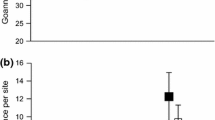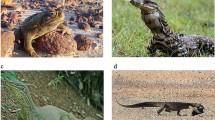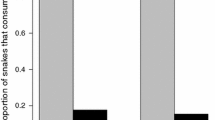Abstract
The impact of invasive predators on native prey has attracted considerable scientific attention, whereas the reverse situation (invasive species being eaten by native predators) has been less frequently studied. Such interactions might affect invasion success; an invader that is readily consumed by native species may be less likely to flourish in its new range than one that is ignored by those taxa. Invasive cane toads (Rhinella marina) in Australia have fatally poisoned many native predators (e.g., marsupials, crocodiles, lizards) that attempt to ingest the toxic anurans, but birds are more resistant to toad toxins. We quantified prey preferences of four species of wading birds (Nankeen night heron, purple swamphen, pied heron, little egret) in the wild, by offering cane toads and alternative native prey items (total of 279 trays offered, 14 different combinations of prey types). All bird species tested preferred the native prey, avoiding both tadpole and metamorph cane toads. Avoidance of toads was strong enough to reduce foraging on native prey presented in combination with the toads, suggesting that the presence of cane toads could affect predator foraging tactics, and reduce the intensity of predation on native prey species found in association with toads.





Similar content being viewed by others
References
Barker RD, Vestjens WJM (1989) The food of Australian birds. Volume 1. Nonpasserines. CSIRO Division of Wildlife and Ecology, Lyneham, Australian Capitol Territory
Beckmann C, Shine R (2009) Impact of invasive cane toads on Australian birds. Conserv Biol 23:1544–1549
Beckmann C, Shine R (2010) Toad’s tongue for breakfast: exploitation of a novel prey type, the invasive cane toad, by scavenging raptors in tropical Australia. Biol Invasions. doi:10.1007/s10530-010-9903-8
Burnett S (1997) Colonizing cane toads cause population declines in native predators: reliable anecdotal information and management implications. Pac Conserv Biol 3:65–72
Caldow RWG, Stillman R, dit Durell SEAV, West AD, McGroty S, Gross-Custard JD, Wood PJ, Humphreys J (2007) Benefits to shorebirds from invasion of a non-native shellfish. Proc Roy Soc Lon B Biol 274:1449–1455
Carlsson NO, Sarnelle O, Strayer DL (2009) Native predators and exotic prey—an acquired taste? Front Ecol Environ 7:525–532
Cogger HG (2000) Reptiles and amphibians of Australia, 6th edn. Ralph Curtis Books, Sanibel Island Fla
Colautti RI, Ricciardi A, Grigorovich IA, MacIsaac HJ (2004) Is invasion success explained by the enemy release hypothesis? Ecol Lett 7:721–733
Crossland MR (2001) Ability of predatory native Australian fishes to learn to avoid toxic larvae of the introduced toad Bufo marinus. J Fish Biol 59:319–329
Crossland MR, Alford RA (1998) Evaluation of the toxicity of eggs, hatching and tadpoles of the introduced toad Bufo marinus (Anura: Bufonidae) to native Australian aquatic predators. Aust J Ecol 23:129–137
Crossland MR, Brown GP, Anstis M, Shilton CM, Shine R (2008) Mass mortality of native anuran tadpoles in tropical Australia due to the invasive cane toad (Bufo marinus). Biol Conserv 141:2387–2394
deRivera CE, Ruiz GM, Hines AH, Jivoff P (2005) Biotic resistance to invasion: native predator limits abundance and distribution of an introduced crab. Ecology 86:3364–3376
Doody JS, Green B, Sims R, Rhind D, West P, Steer D (2006) Indirect impacts of invasive cane toads (Bufo marinus) on nest predation in pig-nosed turtles (Carettochelys insculpta). Wildlife Res 33:349–354
Doody JS, Green B, Rhind D, Castellano CM, Sims R, Robinson T (2009) Population-level declines in Australian predators caused by an invasive species. Anim Conserv 12:46–53
Griffiths AD, McKay JL (2007) Cane toads reduce the abundance and site occupancy of Merten’s water monitor (Varanus mertensi). Wildlife Res 34:609–615
Gruner DS (2005) Biotic resistance to an invasive spider conferred by generalist insectivorous birds on Hawai’i Island. Biol Invasions 7:541–546
Hayes RA, Crossland MR, Hagman M, Capon RJ, Shine R (2009) Ontogenetic variation in the chemical defenses of cane toads (Bufo marinus): toxin profiles and effects on predators. J Chem Ecol 35:391–399
Jensen GC, McDonald PS, Armstrong DA (2007) Biotic resistance to green crabs, Carcinus maenas, in California bays. Mar Biol 151:2231–2243
King RB, Ray JM, Stanford KM (2006) Gorging on gobies: beneficial effects of alien prey on a threatened vertebrate. Can J Zool 84:108–115
Letnic M, Webb JK, Shine R (2008) Invasive cane toads (Bufo marinus) cause mass mortality of freshwater crocodiles (Crocodylus johnstoni) in tropical Australia. Biol Conserv 141:1773–1782
Lever C (2001) The cane toad. The history and ecology of a successful colonist. Westbury, Otley
Llewelyn J, Schwarzkopf L, Alford R, Shine R (2010a) Something different for dinner? responses of a native Australian predator (the keelback snake) to an invasive prey species (the cane toad). Biol Invasions 12:1045–1051
Llewelyn J, Webb JK, Schwarzkopf L, Alford R, Shine R (2010b) Behavioural responses of carnivorous marsupials (Planigale maculata) to toxic invasive cane toads (Bufo marinus). Austral Ecol 35:560–567
Lutz B (1971) Venomous toads and frogs. In: Bucherl W, Buckley EE (eds) Volume II: venomous vertebrates, vol 2. Academic Press, Boston, pp 423–471
Marchant S, Higgins PJ (1990) Handbook of Australian, New Zealand and Antarctic birds. Volume 1, part B. Australian pelican to ducks. Oxford University Press, Melbourne, Australia
Marchant S, Higgins PJ (eds) (1993) Handbook of Australian, New Zealand and Antarctic birds. Volume 2. Raptors to lapwings. Oxford University Press, Melbourne, Australia
Nelson DWM (2008) Bufo for breakfast; how cane toads affect native predators and their prey. BSc Honours thesis. School of Biological Sciences, University of Sydney
Nelson DWM, Crossland MR, Shine R (2010a) Foraging responses of predators to a novel toxic prey: effects of predator learning and relative prey abundance. Okios 120:152–158
Nelson DWM, Crossland MR, Shine R (2010b) Indirect ecological impacts of an invasive toad on predator-prey interactions among native species. Biol Invasions 12:3363–3369
Oakwood M (2003) The effect of cane toads on a marsupial carnivore, the northern quoll, Dasyurus hallucatus. Unpublished progress report to parks Australia North. [See Environment Australia 2003]
Phillips BL, Shine R (2004) Adapting to an invasive species: toxic cane toads induce morphological change in Australian snakes. Proc Natl Acad Sci USA 101:17150–17155
Phillips BL, Shine R (2005) The morphology, and hence impact, of an invasive species (the cane toad, Bufo marinus): changes with time since colonisation. Anim Conserv 8:407–413
Phillips BL, Brown GP, Shine R (2003) Assessing the potential impact of cane toads on Australian snakes. Conserv Biol 17:1738–1747
Price-Rees SJ, Brown GP, Shine R (2010) Are bluetongue lizards (Tiliqua scincoides intermedia, Scincidae) threatened by the invasion of the toxic cane toads (Bufo marinus) through tropical Australia? Wildlife Res 37:166–173
Pysek P, Richardson DM, Pergl J, Jarosík V, Sixtová Z, Weber E (2008) Geographical and taxonomic biases in invasion ecology. Trends Ecol Evol 23:237–244
SAS Institute (1998) SAS/STAT user’s guide. Version 8.0. Volume 1. SAS Institute, Cary, NC
Shine R (2010) The ecological impact of invasive cane toads (Bufo marinus) in Australia. Q Rev Biol 85:253–291
Smith JG, Phillips BL (2006) Toxic tucker: the potential impact of cane toads on Australian reptiles. Pac Conserv Biol 12:40–49
Tyler MJ (1999) Australian frogs. A natural history. Reed New Holland, Sydney
Verhoeven KJF, Simonsen L, McIntyre LM (2005) Implementing false discovery rate control: increasing your power. Oikos 108:643–647
Ward-Fear G, Brown GP, Shine R (2010a) Factors affecting the vulnerability of cane toads (Bufo marinus) to predation by ants. Biol J Linn Soc 99:738–751
Ward-Fear G, Brown GP, Shine R (2010b) Using a native predator (the meat ant, Iridomyrmex reburrus) to reduce the abundance of an invasive species (the cane toad, Bufo marinus) in tropical Australia. J Appl Ecol 47:273–280
Webb JK, Brown GP, Child T, Greenlees MJ, Phillips BL, Shine R (2008) A native dasyurid predator (common planigale, Planigale maculata) rapidly learns to avoid a toxic invader. Aust Ecol 33:821–829
Acknowledgments
This project was funded by the Australian Research Council, Birds Australia, and the Wildlife Protection Society of Australia and supported logistically by the Northern Territory Land Corporation and Beatrice Hill Farm. We thank Eric Cox for logistical support. Two anonymous reviewers provided helpful comments on an earlier draft of the manuscript.
Author information
Authors and Affiliations
Corresponding author
Rights and permissions
About this article
Cite this article
Beckmann, C., Crossland, M.R. & Shine, R. Responses of Australian wading birds to a novel toxic prey type, the invasive cane toad Rhinella marina . Biol Invasions 13, 2925–2934 (2011). https://doi.org/10.1007/s10530-011-9974-1
Received:
Accepted:
Published:
Issue Date:
DOI: https://doi.org/10.1007/s10530-011-9974-1




